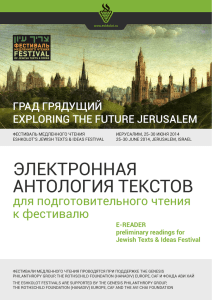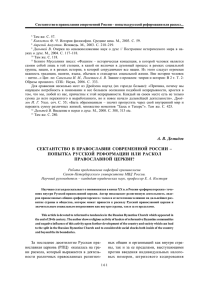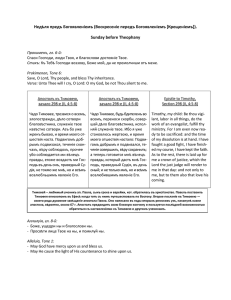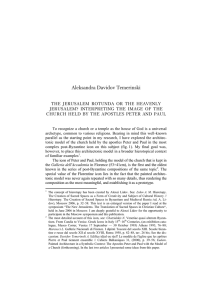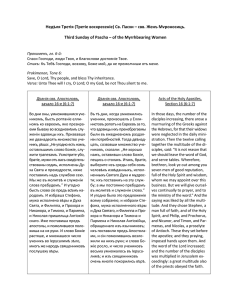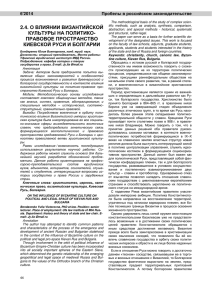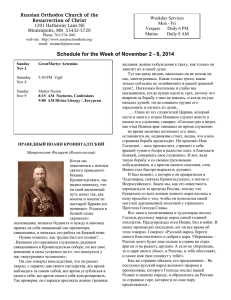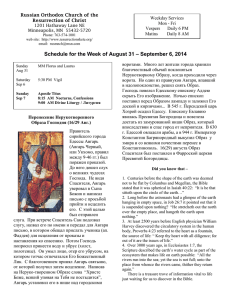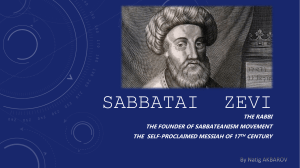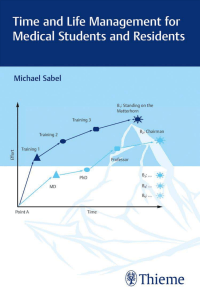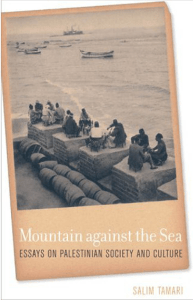Some Hierotopical Aspects of the New Jerusalem Programmes in
реклама
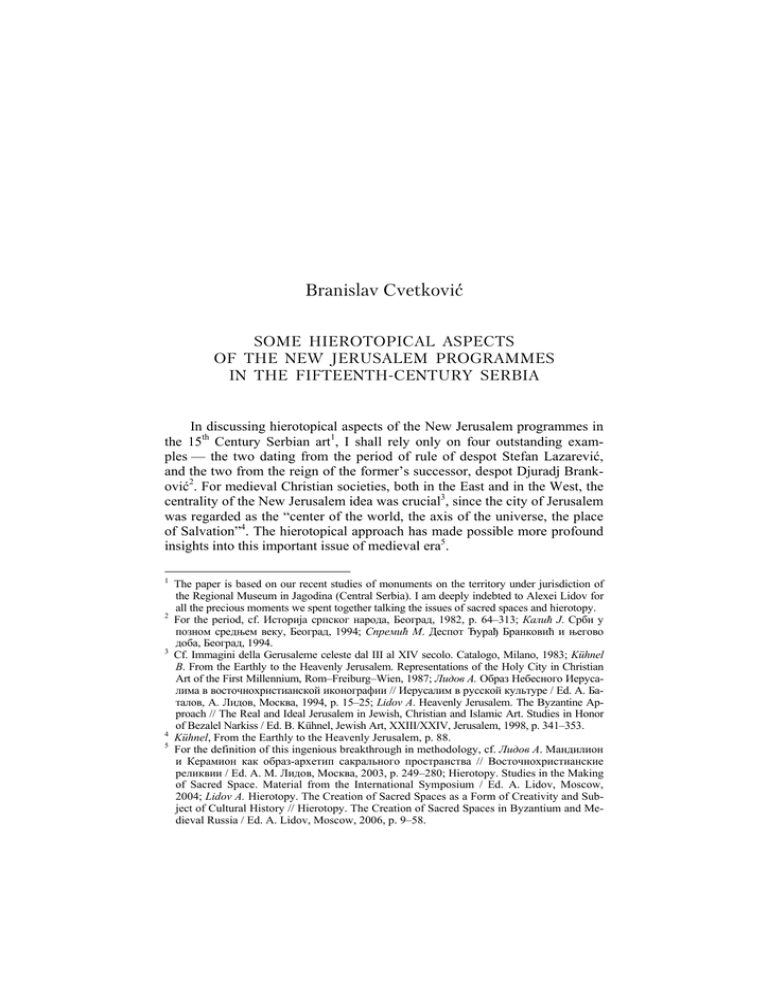
Branislav Cvetkovicv SOME HIEROTOPICAL ASPECTS OF THE NEW JERUSALEM PROGRAMMES IN THE FIFTEENTHCENTURY SERBIA In discussing hierotopical aspects of the New Jerusalem programmes in the 15th Century Serbian art1, I shall rely only on four outstanding examples — the two dating from the period of rule of despot Stefan Lazarević, and the two from the reign of the former’s successor, despot Djuradj Branković2. For medieval Christian societies, both in the East and in the West, the centrality of the New Jerusalem idea was crucial3, since the city of Jerusalem was regarded as the “center of the world, the axis of the universe, the place of Salvation”4. The hierotopical approach has made possible more profound insights into this important issue of medieval era5. 1 2 3 4 5 The paper is based on our recent studies of monuments on the territory under jurisdiction of the Regional Museum in Jagodina (Central Serbia). I am deeply indebted to Alexei Lidov for all the precious moments we spent together talking the issues of sacred spaces and hierotopy. For the period, cf. Историја српског народа, Београд, 1982, p. 64–313; Калић Ј. Срби у позном средњем веку, Београд, 1994; Спремић М. Деспот Ђурађ Бранковић и његово доба, Београд, 1994. Cf. Immagini della Gerusaleme celeste dal III al XIV secolo. Catalogo, Milano, 1983; Kühnel B. From the Earthly to the Heavenly Jerusalem. Representations of the Holy City in Christian Art of the First Millennium, Rom–Freiburg–Wien, 1987; Лидов А. Образ Небесного Иерусалима в восточнохристианской иконографии // Иерусалим в русской культуре / Ed. А. Баталов, А. Лидов, Москва, 1994, p. 15–25; Lidov A. Heavenly Jerusalem. The Byzantine Approach // The Real and Ideal Jerusalem in Jewish, Christian and Islamic Art. Studies in Honor of Bezalel Narkiss / Ed. B. Kühnel, Jewish Art, XXIII/XXIV, Jerusalem, 1998, p. 341–353. Kühnel, From the Earthly to the Heavenly Jerusalem, p. 88. For the definition of this ingenious breakthrough in methodology, cf. Лидов А. Мандилион и Керамион как образ-архетип сакрального пространства // Восточнохристианские реликвии / Ed. А. М. Лидов, Москва, 2003, p. 249–280; Hierotopy. Studies in the Making of Sacred Space. Material from the International Symposium / Ed. A. Lidov, Moscow, 2004; Lidov A. Hierotopy. The Creation of Sacred Spaces as a Form of Creativity and Subject of Cultural History // Hierotopy. The Creation of Sacred Spaces in Byzantium and Medieval Russia / Ed. A. Lidov, Moscow, 2006, p. 9–58. 608 Branislav Cvetkovicv Although the most important foundation of despot Stefan, the Resava monastery6 was only a part of a much larger project, including the new capital city of Belgrade7. The remaining structures of the monastery and the sophisticated decoration of its church8 recreate vividly the New Jerusalem symbolism referred to in despot’s Vita, written by Constantine of Kostenec9. The well known quotation from this highly important text: “iny ùe pakyj grady vyspomenouti namy naxodity iùe ky vyjwynëmou Jerosolimou styÂü imaty i podobie”, indicates that the Resava’s ktetor had built his monastery of St Trinity “in imitation of and as a path to the Heavenly Jerusalem”, “because he desired to dwell and talk with the hermits”10. Being composed on encomiastic basis the Vita abounds with numerous symbols and metaphors. Throughout the despot’s Vita Constantine of Kostenec makes direct and repeated allusions to Stefan’s virtues in comparing him with a number of Antique and Old Testament models, but most often with Solomon11. The recent thorough textology analysis of the Vita has un6 For the monastery of Resava (also called Manasija), cf. Тодић Б. Манастир Ресава, Београд, 1995 (with full bibliography). Also, see proceedings of the 1994 Symposium on the Manasija Monastery and its Time, cf. Манастир Ресава. Историја и уметност / Ed. В. Ј. Ђурић, Деспотовац, 1995. 7 On the medieval city of Belgrade, cf. Поповић М. Београдска тврђава, Београд, 1982; Калић-Мијушковић Ј. Београд у средњем веку, Београд, 1967; Поповић М, Бикић В. Комплекс средњовековне митрополије у Београду, Београд, 2004; Поповић М. Београдска тврђава. Друго допуњено издање, Београд, 2006. Also, cf. Ердељан Ј. Београд као Нови Јерусалим. Размишљања о рецепцији једног топоса у доба деспота Стефана Лазаревића // ЗРВИ, 43 (2006), p. 97–109. 8 For the Thessalonican origin of the painters, cf. Djurić V. J. La peinture murale de Resava. Ses origines et sa place dans la peinture byzantine // Моравска школа и њено доба, Београд, 1972, p. 227–291; Стародубцев Т. Сликари задужбина Лазаревића // ЗРВИ, 43 (2006), p. 359–367. 9 Јагић В. Константин Философ и његов Живот Стефана Лазаревића деспота српскога // Гласник СУД XLII (1875), p. 223–328 (from now on: Живот); Константин Филозоф. Повест о словима (Сказаније о писменех) — изводи и Житије деспота Стефана Лазаревића // Стара српска књижевност у 24 књиге, 11 / Ed. Г. Јовановић, Београд, 1989 (from now on: Житије). On topoi in the Vita, cf. Radošević N. Laudes Serbiae. The Life of Despot Stephan Lazarević by Constantine the Philosopher // ЗРВИ, 24–25 (1986), p. 445–451. 10 Живот, p. 288; Житије, p. 103. For specific rulers’ ideology based on ascetic and monastic grounds, cf. Марјановић-Душанић С. Владарска идеологија Немањића. Дипломатичка студија, Београд, 1997, p. 234–246, 275–286; Eadem Династија и светост у доба породице Лазаревић: стари узори и нови модели // ЗРВИ, 43 (2006), p. 77–92; Радујко М. Копорин, Београд, 2006, p. 234–255. 11 For notions of New David and New Solomon in medieval ideology, cf. Марјановић-Душанић С. Rex Imago Dei: о српској преради Агапитовог огледала // Трећа југословенска конференција византолога, Крушевац 10–13. мај 2000, Београд–Крушевац, 2002, p. 145; Ousterhout R. New Temples and New Solomons // The Old Testament in Byzantium, Byzantine Studies Winter Symposium, December 1–3, 2006 / Ed. P. Magdalino, R. Nelson // Dumbarton Oaks, Washington D.C., Abstracts. Some Hierotopical Aspects in the FifteenthCentury Serbia 609 covered its consistent numerological structure: this uniquely conceived literary work insisted on despot’s special personality picturing him as a highly educated man, writer, prophet and a holder of secret knowledge12. The complex symbolism of the Heavenly Jerusalem in Resava starts unfolding at the very meeting point of earthly and heavenly realm — the ktetor’s portrait (Fig. 1)13. Lavishly composed it reflects much more than the standard ruler’s likeness. The despot presents his novel foundation to the Holy Trinity, painted in form of the three angels residing in front of symbolical architecture. Since it completely follows a form of the celestial palace labeled Holy Sion as seen in the marginal illustration of the Psalm 77 in the Khludov psalter, one has to conclude the angels in Resava are also seated before the Heavenly Jerusalem14. In its basic outlook despot’s portrait is similar to typical royal donor portraits, as he was represented with insignia coming from above, including the large cruciform scepter in his right hand15. However, the portrait is actually unique as he holds in his left hand both the model of his foundation and an open scroll. It has earlier been thought that the scroll stands for a charter roll16, but the text written on it exhibits an eschatological prayer instead17. Therefore the portrait should not be confused with the royalty figures holding charters, which emphasize their being founders or donors18. The large open scroll visually categorizes Stefan amongst the prophetic order: he was meant to be seen as the prophet, the Christ’s vicar and the national hero19. The actual background for such a portrait must have been despot’s personal aura and the strong general sentiment of the period mostly spoken of in terms of the last years or the years of sorrow, marking the widespread expectation of the End of the World20. 12 For significant results of the research of Stefan’s Vita, cf. Георгиева Н. Житието на Стефан Лазаревич от Константин Костенечки и царската словесна иконография през XV век // Българският петнадесети век, София, 1993, p. 161–180; Eadem Едно необичайно иконографско решение при изoбразяването на владетеля в житието на деспот Стефан Лазаревич от Константин Костенечки, Старобългарска литература, София, 1983, p. 25–26, 155–166. 13 On despot’s portraits in several Serbian churches, cf. Војводић Д. Владарски портрети српских деспота // Манастир Ресава. Историја и уметност, Деспотовац, 1995, p. 65–95. 14 Щепкина М. Миниатюры Хлудовской псалтири. Москва, 1977, fol. 79 r. Also, cf. Лидов, Образ Небесного Иерусалима в восточнохристианской иконографии, p. 17–18, fig. 3. 15 Cf. Ђурић В. Ј. Нови Исус Навин // Зограф 14 (1983), p. 10. 16 Cf. Ђурић В. Ј. Портрети на повељама византијских и српских владара // ЗФФ, VII-1 (1963), p. 265. 17 For the text on the despot’s scroll, cf. Тодић, Манастир Ресава, p. 64. 18 As in Ђурић, Портрети на повељама византијских и српских владара, p. 251–269. 19 Cf. Чајкановић В. Митски мотиви у традицији о деспоту Стефану // Богословље, 2 (1927), p. 180–187; Јовановић Г. Трагови народних веровања у „Сказанију о писменех“ Константина Филозофа // Српска књижевност у доба Деспотовине, Деспотовац, 1998, p. 205–210; Милошевић-Ђорђевић Н. Народна предања о деспоту Стефану // Српска књижевност у доба Деспотовине, p. 197–204. 20 Ćirković S. Kraj veka — kraj sveta. Strepnje i iščekivanja kod Srba u vezi sa 7000. godinom // Jugoslovenski istorijski časopis, 1–2 (1996), p. 11–24. 610 Branislav Cvetkovicv The New Jerusalem themes in Resava can also be seen close to despot’s figure: in the lunette we see Christ Anapeson, the God’s Hand and the prophets David and Solomon21. Although these frescoes match the entrance iconography as in other instances, the placing of the two prophets near the despot’s portrait can be sustained by the Vita text, where he was described as prophet and continually compared with David and Solomon22. However, it is noteworthy that Solomon is twice more often referred to than David, and this statistics is in perfect accordance with the fact that Solomon, and not David, is placed nearer to the ruler’s figure23. The Solomonic symbolism of despot’s figure in Resava is obvious even in such details as the suppedion cushion under his feet (Fig. 2). Instead of double-headed eagles which were usually found on such insignia, here we see lions24, as possible allusion to the Solomonic throne,25 found also on the imperial portrait of John II in the famous manuscript Urb. gr. 226. It is noteworthy that the figures of David and Solomon were included in the major dome of the Ravanica church, unlike the Resava, where from their figures have been left out, but painted in the first zone, near the ruler’s portrait27. What was so important in stressing this rather topical iconography? The key again provides the Vita where its author reflects on despot’s ambition to erect the church after the model of his father’s28. This very notion recalls the 21 Todić B. Anapeson. Iconographie et signification du thème // Byzantion, LXIV/1 (1994), p. 134–165. 22 Живот, 281; Житије, 98. 23 For David, cf. Житије, p. 75, 101, 104, 126, 127, 129, 130. For Solomon, cf. Житије, p. 75, 76, 79, 86–88, 101, 102, 104, 128–130. 24 Some scholars have mistook the lion for a griffin, as in Тодић, Манастир Ресава, p. 100, or a wolf, as in Томић С, Николић Р. Манасија. Историја — живопис // Саопштења VI (1964) p. 55, T. VIII/8. See now Cvetković B. Imago leonis in Despot Stefan’s Iconography // The Second International Conference of Iconographic Studies: Animal Symbolism in Christian Art and Literature. Rijeka, May 22–24, 2008, Abstracts, = Ikon, 2 (2009) (forthcoming). 25 Deér J. The Dynastic Porphyry Tombs of the Norman Period in Sicily // DOS V, Cambridge, 1959, Fig. 14; Forsyth I. H. The Throne of Wisdom: Wood Sculptures of the Madonna in Romanesque France, Princeton, 1972; Mango C. The Art of Byzantine Empire 312–1453. Sources and Documents. Englewood Cliffs, 1972, p. 209. 26 For the colour plate, cf. Maguire H. Images of the Court // The Glory of Byzantium. Art and Culture of the Middle Byzantine Era, A.D. 843–1261 / Ed. H. C. Evans, W. D. Wixom. New York, 1997, fig. 144. Cf. Spatharakis I. The Portrait in Byzantine Illuminated Manuscripts, Leiden, 1976, p. 81, f. 46 who identifies lions as “hindquarters of two animals”, while Hadermann-Misguich L. Tissus de pouvoir et de prestige sous les Macedoniens et les Comnenes. A propos des coussins-de-pieds et de leur representations // DCAE, 4 (1994), p. 128, sees “cats” in them. 27 For the New Jerusalem iconography in Ravanica, cf. Стародубцев Т. Представа старозаветног Веселеила у олтару Раванице // ЗРВИ, 39 (2001/2002), p. 249–261. 28 Житије, p. 87. Some Hierotopical Aspects in the FifteenthCentury Serbia 611 Old Testament king and prophet Solomon as the builder of the Jerusalem temple, the one started but not completed by his father David, in a way the anecdote with emperor Justinian conveyed his joy exclaiming victory over Solomon upon his entering Haghia Sophia29. The historical context helps to grasp the idea, as there is clear analogy between Stefan and his father, the prince Lazar, to the king Solomon and his father, king David: Stefan was the heir of the prince Lazar, the founder of the new Serbian dynasty, exactly as Solomon was the son and heir of David, himself founder of the new dynasty of Israel, chosen by God30. There is a striking consequence with both intentional comparisons to biblical models, as the rebuilding of Jerusalem was needed for the salvation after great tragedies31. The Serbian context perfectly matched that model as both Lazar and Stefan had erected major foundations in expectation of God’s mercy. After the Serbian Empire had dissolved, it was prince Lazar as the New David that invoked the mercy from on high by building the five-domed Ravanica for his own mausoleum church32. His son and successor Stefan, following the church plan of his father’s, after a series of new losses and disasters (one of them the Kosovo battle), had built his own monastery at Resava. It looks the historical context may explain special outlook of certain architectural features connecting the two mausolea, e.g. the unique lavishly adorned collonetes appearing on four massive pillars in both Ravanica and Resava. The problem deserves more attention, as the unusual architectural image of the pillars may signify the mercy spilling from the heavens. Recreating this and other features from his father’s church, Stefan may have aimed at stressing legitimacy of his own rule. In combined historical, theological and eschatological time, the dedication of these two churches should also be seen as intentionally diachronic, since prince Lazar’s Ravanica was dedicated to the Ascension, while despot Stefan’s Resava to the Trinity, the Pentecost feast33. The church of the Kalenić monastery34, built as the joint foundation of despot Stefan and the protovestiarios Bogdan35, is surely one of the most im29 Дагрон Ж. Цар и првосвештеник. Студија о византијском „цезаропапизму“. Београд, 2001, p. 250–256. 30 Kühnel, From the Earthly to the Heavenly Jerusalem, p. 20–27. 31 Ibidem, p. 30. 32 For Lazar’s reign, cf. Михаљчић Р. Лазар Хребељановић. Историја, култ, предање. Београд, 1989. 33 Cf. Ђурић В. Ј. Посвета Немањиних задужбина и владарска идеологија // Студеница у црквеном живопису и историји српског народа. Београд, 1987, p. 13–35. 34 Ђурић В. Ј. Сликар Радослав и фреске Каленића // Зограф, 2 (1967), p. 22–29; Живковић Б. Каленић. Цртежи фресака. Београд, 1982; Ђурић В. Ј. Византијске фреске у Југославији. Београд, 1974, 101–104, 225; Simić-Lazar D. Kalenić et la dernière période de la peinture byzantin. Skopje–Paris, 1995; Eadem. Каленић. Сликарство, историја. Крагујевац, 2000. 612 Branislav Cvetkovicv portant monuments in medieval Serbian art36. Dedicated to the Presentation of the Virgin in the Temple, its facades have been elaborately conceived and executed as the recreation of the Heavenly Jerusalem37. Its fresco programme too has been decisively influenced by the New Jerusalem iconography. The narthex programme comprises the holy desert fathers, the portraits of ktetors and the Deesis group in the first zone, while on the walls there is the cycle of the Virgin’s and of Christ’s Infancy38. Because of the special needs and of the dedication of the church, the painters adapted the number and the disposition of the scenes, omitting some of the episodes or emphasizing others. The programme’s creator had special ideas as he deliberately chose to exclude several scenes from the cycle, e.g. Massacre of the Innocents. In doing so he accentuated two opposite scenes — Flight into Egypt and Enrollment for Taxation, both covering the width of the wall (Fig. 3–4). What he had achieved in that way is that the former was painted above the ktetor’s portraits, which was an original way to express the founders’ faith. The Flight into Egypt is not only found as part of the cycle of the Holy Virgin, but also in the Akathistos cycle, in the painted calendars as illustration of the second Christmas day, and in the Psalters. The New Testament story says that Joseph followed a vision from a dream to flee with the Virgin and Christ from persecutions and find salvation in Egypt (Matthew 2, 14). The story has been interpreted by St John Chrysostome and Theophilactos as one should follow God’s command in order to save himself, because the just, and all having faith in Lord — the God-loving and God-fearing people who listen to his commands, would be saved39. The metaphor alluding to the joint ktetorship of the ruler and his nobleman of uncertain origin introduces the idea that a just man always relies on God's providence and that salvation is always accompanied by a return of the scattered people of Israel to Jerusalem (Isaiah 2, 1–4; Jeremiah 31, 10)40. The parallel processions of the Holy Family and of the nobles are shown actually heading eastward, as if entering the nave, representing the Heavenly Jeru35 Cf. Цветковић Б. Герасимов запис и ктитори Каленића // Саопштења, XXIX (1997), p. 107–122. On Bogdan the protovestiarios, cf. Ћирковић С. М. О ктитору Каленића // Зограф, 24 (1995), p. 61–67. On recently discovered correspondence between Bogdan and the Sultan, cf. Kolovos I. A Biti of 1439 from the Archives of the Monastery of Xeropotamou (Mount Athos) // Хиландарски зборник, 11 (2004), p. 295–305. 36 For general information on the Kalenic monastery, cf. Ристић В. Моравска архитектура. Крушевац, 1996, p. 217 et passim, fig. 53–56. 37 Стевовић И. Д. Каленић. Богородичина црква у архитектури позновизантијског света. Београд, 2006. 38 Lafontaine-Dosogne J. Iconography of the Cycle of the Life of the Virgin // The Kariye Djami, 4, Princeton, 1975, p. 161–194. 39 Cf. manuscripts Дечани 22, fol. 30 r; МСПЦ 100, fol. 57v–64r; Маринковичь К. Толкованіе священыхь еваггелий. Нови Садь, 1839, p. 197–198, 200. 40 Kühnel, From the Earthly to the Heavenly Jerusalem, p. 29. Some Hierotopical Aspects in the FifteenthCentury Serbia 613 salem. The founders truly hoped that, being just and God loving Christians, they would deserve a place in the celestial realms of the Upper Sion. The painter of Kalenić transformed already seen schemes in Christ Chora and Curtea de Argeş: the city of Nazareth, which in the Journey to Bethlehem in Chora resembles a background vignette41, it actually crowns the sumptuous gate of the Kalenić nave as a celestial city (Fig. 5). The aspect of Nazareth as a city with walls and towers from Chora has been completely transformed in Kalenić into celestial palace, the metaphor “of an Upper City of the righteousness, Jerusalem above Earth”42. The Enrollment for Taxation is connected to the entrance iconography too. The point of accent is the painted relief of the Virgin and Christ Child on the outer side of the south door, close to the Census fresco43. The Virgin’s figure is surrounded by unusual mandorla recalling the symbolism of the Virgin as the Fotodochos Lampas, the Light Shining Candle of the Akathistos hymn44. It also signifies the “unfalling pillar“ and the „closed gate“, as all the elements of this nuanced iconography are present45. It is in this context that one can deduce the symbolics of the Enrollment for Taxation as the open scroll is indeed crucial element in recalling the words of Jesus: “rejoice that your names are written in heaven” (Luke 10, 20). The Akathistos hymn too refers to the scroll written by the hand of the Lord as the Virgin is asked to pray to enroll the faithful in the book of life46. These sentences are based on Old Testament quotations, used by St Paul in creating theology of spiritual citizenship (Phil. 3, 20), and of the faithful recorded in the book of life (Phil. 4, 3). The same ideas are found in the Revelation (21, 27), so the Book of Life is nothing else but the list of those who have been enrolled as citizens of the Heavenly Jerusalem. Unlike the notion accentuating the “taxation moment” in the fresco47, we believe it is the “enrollment” instead that enables appropriate 41 Симић-Лазар, Каленић, p. 231–238 (with bibliography); Ousterhout R. The Art of the Kariye Camii. London–Istanbul, 2002, p. 48. 42 Теодосије, Службе, канони и Похвала. Београд, 1988, p. 228. 43 For traces of the original revetment on the relief cf. Цветковић Б. Рељефна представа Богородице с Христом у Каленићу // Гласник ДКС, 32 (2008), p. 90–92. Cf. Velmans Т. Le décor sculptural d'une fenêtre de l'église de Kalenić et le thème de la fontaine de la vie // ЗЛУМС, 5 (1969), p. 89–93; Стевовић, Каленић, p. 174–176. 44 Джурова А. Томичов псалтир. Том втори // Monumenta slavico-byzantina et mediaevalia europensia, Vol. I, София, 1990, p. 299v, 300r. 45 Джурова А. Томичов псалтир, p. 295v, 296r. The Virgin as the closed gate with two cherubims is identical to the Ohrid Perivletpos example, cf. Грозданов Ц. Проучување на живописот во Свети Климент (Богородица Перивлептос) // Студии ѕа охридскиот живопис, Скопје, 1990, p. 91, fig. 17. 46 Джурова А. Томичов псалтир, p. 297r–297v. 47 Cf. Nelson R. Taxation with Representation: Visual Narrative and the Political Field at the Kariye Camii // Art History, 22/1 (1999), p. 56–82; Ousterhout, The Art of the Kariye Camii, p. 122–124. 614 Branislav Cvetkovicv understanding of the iconography and moreover the symbolism of the whole narthex48. The open scroll as central motive in the Taxation scene matches the significance of the Akahistos scroll as symbol of Logos, present in St Paul’s epistles as well. But what connects the St Paul’s figure from the first zone of the Kalenić narthex with the Taxation scene above, is inevitably St Antony the Great’s figure, for his famous sentence was: “…from then on there were many monasteries in the mountains and the desert was made a city by monks who … registered themselves for the citizenship in the heavens”49. This quotation makes clear allusion to the monastic world as the recreation of the Heavenly Jerusalem, and can be found in contemporary texts of Antony’s vita, such is Chil. 278: “i sice proqe byjwe i po goraxy monastiri. i poustinä grady sytvori se mnixœmy. izywdywimy œty svoixy i napisavwimy sebh vy nebesnhmy ùitelstvh”50. Majestic figures of the Serbian saints St Symeon Nemanja on the south wall and of St Sava the Serbian on the north wall of the western bay are crucial for the iconography of the nave. In the north side of the western wall, there are also figures of St Emperor Constantine and his mother Helena, both in royal costumes, holding the honourable Cross with the Christ’s victorious monogram (Fig. 6), and on the south side the figures of St John the Almsgiver and of St Nicholas of Myra. Above the west gate there are half figures of the prophet Daniel and the Three Hebrews. The fresco icons of St Symeon and St Sava in the Kalenić church, being pendants, create the axis of the special entrance iconography. The particular cultic function of the west bay is revealed by the profiled beams as sacred “frames” of the icons matching the concept of the symbolic rulership of St Symeon and St Sava51. The figures of these “two holy ones” were painted on the west pillars in the monastery of Koporin too, also as guardians and symbolic columns of the State and Church, “ who pray to God to fortify the Serbian Lands and to preserve it 48 De Vries-van der Velden E. Census Augusti, Dei Census: Reflections on an Image in the Kariye Camii // Constructions of the Greek Past. Identity and Historical Consciousness from Antiquity to the Present / Ed. H. Hokwerda. Groningen, 2003, p. 117–156. Cf. Gerov G. The Narthex as Desert: The Symbolism of the Entrance Space in Orthodox Church Buildings // Ritual and Art. Byzantine Essays for Christopher Walter / Ed. P. Armstrong, London, 2006, p. 144–159. 49 Vita Antonii, PG 26: 865АB; Athanasius. The life of Antony and the Letter to Marcellinus / Ed. R. C. Gregg, W. A. Clebsch. New York, Ramsey, Toronto, 1980, p. 42–43; Поповић Ј. Житије преподобног оца нашег Антонија Великог // Житија светих за јануар. Ваљево, 1991, p. 532. 50 Хил. 278, fol. 164v. Cf. Витић-Недељковић З. Житије Светог Антонија у српској рукописној традицији // Археографски прилози, 21 (1999), p. 37–131, esp. p. 104–105. 51 Стевовић, Каленић, p. 176–181, T. XI, XII. For cults of Sts Symeon Nemanja and Sabas the Serbian, cf. Поповић Д. Под окриљем светости. Култ светих владара и реликвија у средњовековној Србији. Београд, 2006, p. 27–118. Some Hierotopical Aspects in the FifteenthCentury Serbia 615 and defend it from the attacks of enemies”52. The disposition of the icons of St Symeon and St Sava in Kalenić follow the topography of the Nemanja’s tomb in the Studenica monastery and of the Sava’s tomb in the Mileševa monastery, apparently reinstalling content of their cult in the symbolic transfer of these “loca sancta”. Therefore, it is the context of “translatio Hierosolymi” which forms the basis that provides proper ideological and religious focus to the icons of St Symeon and of St Sava in the specially created sacred space of the Kalenić west bay. The paintings below the windows represent the ancient symbol (rectangle divided in four parts, with an inserted octagon composed of two squares with a circle in its centre), proving the cultic function of the lateral spaces. The busts of the prophet Daniel and the Three Hebrews contribute to this special iconography. This fresco, well emphasized above the gate, apart from being the symbol of the Resurrection and the Eucharist, also symbolizes faith and resistance to tyranny personified in Nebuchadnezzar. That the accent on these figures is indeed an allusion to a particular moment in history corroborates the Vita of Despot Stefan, because its author identifies the Turkish sultan with Nebuchadnezzar, and despot Stefan with Daniel and his courageous friends53. The enigmatic figure of the Archangel Michael, incised in the profile of the beam in the south-west angle of the bay, also belongs to this iconography (Fig. 7). If the object in the Archangel’s hand is not a model of the building as previously thought54, but the royal crown perhaps, in that case this unusual relief is analogous to the Archangel who, after having won over Satan, gives over the insignia of power to God (the example in Lesnovo) (Fig. 8)55. In the monastery of Dečani, the angels who in the scene of the Anastasis bring to Resurrected Christ the symbols of power are also analogy for the Kalenić Archangel and contribute to the understanding of its eschatologic symbolism (Fig. 9)56. It is the Book of the prophet Daniel that can explain this rather unusual iconography, with the prophet’s figure painted in immediate proximity to the Archangel. The quotation introduces Archangel Michael as a saviour of the just who are registered in the Book of Life (Daniel 12, 1–4). The special role of Daniel in Kalenić is obvious especially through his figure in the dome: 52 Радујко, Копорин, p. 235–248. Житије, p. 76, 81, 125. Cf. Цветковић Б. Каленић: иконографија и политичка теорија // Научни скуп, Манастир Каленић: ка Шестој стогодишњици, Манастир Каленић. 4–6 октобар 2008 (forthcoming). 54 Cf. Стевовић, Каленић, p. 178–181, T. XIII. 55 Габелић С. Манастир Лесново. Историја и сликарство, Београд, 1998, p. 95–96, fig. 33; Eadem, Byzantine and Post-Byzantine Cycles of the Archangels (11th to 18th Century). Corpus, Belgrade, 2004, p. 94, fig. 102, T. VIII. 56 Марковић М. Циклус Великих празника // Зидно сликарство манастира Дечана. Грађа и студије / В. Ј. Ђурић, Београд, 1995, p. 112–117, fig. 7; Тодић Б, Чанак-Медић М. Манастир Дечани, Приштина — Београд, 2005, p. 374, fig. 294. 53 616 Branislav Cvetkovicv he is the only prophet whose scroll has the text written with “pseudo-letters”, as an allusion to the “Chaldeic” inscription written by the Hand of God, also according to the Book of Daniel (Daniel 5, 5–28). An interesting asymmetric structuring of the main fresco cycle of the Lord’s miracles and parables can be seen in the nave at Kalenić. The two scenes are made at least twice larger than the others from the cycle, namely, the Marriage at Canaa, painted on the eastern side of the southern choir (Fig. 10), and the Multiplication of the Loaves, covering the larger part of the same zone on the western wall of the nave57. Illustrating Christ’s first and most important miracle, the Canaa fresco was excellently visible to all present at the liturgy facing the altar, while the Multiplication scene attracted the attention of the faithful in the same manner, as they turn around to leave. The actual reason for making them larger than the other scenes was evidently liturgical, both being references to Eucharist, symbolizing through images of Christ's blood and body Christ's passion and its soteriological significance58. In a more general sense of the popular devotion, the very positioning and large dimensions of the Canaa fresco had solid grounds in the orthodox wedding practice, where the story of the Marriage at Canaa is quoted during the service, while the blessed wine given by a priest to the bride and groom is compared to the miraculous wine at Christ's Canaa59. But, the Kalenić Canaa fresco is best known for its unusual detail — the groom piercing his bride’s finger with a knife. The fact that the Canaa fresco is painted between the Annunication and Raising of Daughter of Jairus, and under the Presentation in the Temple, brings in liturgical strata of the fresco’s position. The proximity of the Annunciation scene especially recalls direct liturgical influence as the Solomon’s Proverb IX, 1 with Eucharistic symbols as the table of wisdom, and Virgin as the prefiguration of the church, is part of the service for the feast of the Annunciation, along with other Virgin’s feasts60. That obviously eucharistic though quite original symbol, and not a pagan one as has been proposed in the past61, is not the only unusual feature of that fresco. Namely, it is the outlook of the collonaded table that reflects educated creators of the Kalenić programme. If we take a closer look we shall find out that the front side of the table is uniquely rendered — it is formed by seven columns recalling the symbolism of the Solomon’s Tem57 Симић-Лазар, Каленић, p. 185–191. The two scenes are also emphasized in Chora, placed above the icons of Christ and the Virgin, cf. Ousterhout R. Temporal Structuring in the Chora Parekklesion // Gesta, 34/1 (1995), p. 66–68. 59 Мирковић Л. Православна литургика, 2, Београд, 1983, p. 137–138. 60 Војводић Д. Зидно сликарство цркве Светог Ахилија у Ариљу. Београд, 2005, p. 48–49. 61 Cf. Радојчић С. Каленић, Крагујевац, 1987, p. XV–XVI. 58 Some Hierotopical Aspects in the FifteenthCentury Serbia 617 ple and of God’s Wisdom62, which can be understood as being influenced by liturgical readings for the Annunication63. The juxtaposition of the Canaa with the Raising of the daughter of Jairus can also be explained by liturgical quotation found in Epifanius of Cyprus’ words that the table has been set, the meal prepared, the eternal dwellings are ready, the treasures of the just have opened, and the heavenly kingdom has come before time64. That the painter really inferred the New Jerusalem symbolism, can best be seen in that he minutely executed the seven bases of all the columns, as in classical illustrations of the scene The Wisdom has built her house and set seven columns, as in Perivleptos in Ohrid, Gračanica, the Virgin Odegetria in Peć or Ljeviška in Prizren65. That the table symbolically refers to the temple is proven by the outlook of the Solomon’s temple in the Koimesis fresco in Staro Nagoričino66. The unique rendering of the narthex programme, and of some parts of the nave, can be understood if seen within the context of the close relationship of the nobility and the ruler. Their devotional and corporeal benefits lay behind the foundation of the Kalenić monastery as their joint enterprise67. Creators of the sacred space in Kalenić are not to be looked for only among the ktetors painted on the north wall of the narthex. Traces of two monastic portraits in the dado zone indicate that the two monks had the right to be portrayed too. We can only suggest their special role in creating the sacred space in Kalenić, bearing in mind that similar portraits of influential abbots have been known (among the oldest the ones from St Catherine on Sinai)68. The assumption that these very monks may have been involved in conceiving the unique complex of the Kalenić church has strong grounds. The remaining inscriptions reveal that the name of the first started with a letter V, while the name of 62 Meyendorff J. L’iconographie de la Sagesse divine dans la tradition byzantine // CA, X (1959), p. 259–277; Die Weisheit baute ihr Haus / Ed. K. Ch. Felmy, E. Haustein-Bartsch, München, 1999; София Премудрость Божия / Выставка русской иконописи XIII–XIX веков из собраний музеев России. Москва, 2000. 63 Ђорђевић И. М. О сликаним програмима српских цркава XIII столећа // Краљ Владислав и Србија XIII века. Београд, 2003, p. 154, 160–162; Војводић Д. Зидно сликарство цркве Светог Ахилија у Ариљу, p. 48–49. 64 Vaillant A. L’homélie d’Épiphane sur l’ensevelisement du Christ // Radovi Staroslovenskog Instituta, 3 (1958), p. 80. 65 Грозданов Ц. Проучување на живописот во Свети Климент (Богородица Перивлептос), p. 97, fig. 18; Панић Д, Бабић Г. Богородица Љевишка. Београд, 1975, p. 77, 138; Тодић Б. Грачаница. Сликарство, Београд — Приштина, 1988, p. 144–145, T. IV; Милановић В. “Пророци су те наговестили” у Пећи // Архиепископ Данило II и његово доба. Београд, 1991, p. 410, fig. 2. 66 Тодић Б. Старо Нагоричино, Београд, 1993, p. 107, fig. 26. 67 Стевовић И., Цветковић Б. Манастир Каленић, Београд, 2007. 68 Cormack R. Byzantine Art, London, 2000, p. 48–53, fig. 26. 618 Branislav Cvetkovicv the other was Dositheos69. The latter can be identified with the famous scribe Dositheos, also called Moses, the author of important inscription regarding the personality of despot Stefan70. Identical sequence of columns can be seen on the famous Esphigmenou charter, bearing miniature portraits of the family of despot Djuradj Branković71. In the lower part of the miniature the intercolumniations are set behind the figures of princes Stefan and Lazar, and their sister princess Kantakuzina (Fig. 11), while in the upper part there are portraits of despot Djuradj Branković, his wife Irina, of prince Grgur and princess Mara (Fig. 12). In previous scholarship the background architecture in the lower part has been described as being made of six windows. I propose we should count seven columns instead of windows. The meaning of painted architecture with golden background behind the Branković figures has never been established with certainty. It was mainly referred to as symbolic or fantastic architecture, and as the possible reflection of the Žiča monastery architecture, as the place the charter had been issued72. Conversely, the high architectural structures in the upper part of the charter have been described as “kiosks”, ciborium and rotunda. I believe the idea that lay behind such a complex miniature must had been that of the Heavenly Court. The proof that it too belongs to the New Jerusalem symbolism is provided by the Dečani fresco of the Wisdom Sending Her Attendants Forth, illustrating Proverbs IX, 3–4, with identical architectural elements (Fig. 13)73. It is the late print of prince Lazar that corroborates our thesis, which was a long time ago interpreted by V. Han as the scene of the prince standing in the architecture of Jerusalem (Fig. 14)74. Therefore, it looks that in the wake of disastrous events for Serbia the full circle has been achieved, as the ruler’s sons have identical tall hats as the holy warriors in classical scenes of the Heavenly Court in the churches of 69 Симић-Лазар, Каленић, p. 79, 252. Стојановић Љ. Стари српски записи и натписи 1, Београд, 1902, p. 71–72. 71 For the last edition, cf. Ivić P, Djurić V. J, Ćirković S. The Esphigmenou Charter of Despot Djuradj. Beogad — Smederevo, 1989. 72 Радојчић С. Портрети српских владара у средњем веку, Скопље, 1934, p. 72; Ђурић В. Ј. Портрети на повељама византијских и српских владара // ЗФФ, VII-1 (1963), p. 253–254; Idem. Portraits of Byzantine and Serbian Rulers // The Esphigmenou Charter of Despot Djuradj, p. 30; Idem. Друштво, држава и владар у уметности у доба династије Лазаревић-Бранковић // ЗЛУМС, 26 (1990), p. 29–30. The miniature has recently been discussed by Milanovic Lj. Reconsidering the Significance of the Esphigmenou Chrysobull // The Thirtieth Annual Byzantine Studies Conference, Baltimore MD, 2004. 73 Милановић В. Старозаветне теме и Лоза Јесејева // Зидно сликарство манастира Дечана. Грађа и студије / Ed. В. Ј. Ђурић, Београд, 1995, p. 213–214, fig. 2; Тодић Б, ЧанакМедић М. Манастир Дечани, p. 357–359, fig. 279, 280. 74 Хан В. Прилог познавању иконографије кнеза Лазара // Рад војвођанских музеја, 7 (1958), p. 63–74 has proved that the print actually illustrated the verses from an old Serbian chronicle presenting accounts from the alleged pilgrimage of the Prince to Jerusalem. 70 Some Hierotopical Aspects in the FifteenthCentury Serbia 619 Treskavac, Peribleptos in Ohrid, Zaum or Markov manastir75. The family portrait of the Branković dynasty is the perfect example of mixed iconography — the overall Byzantine background with the New Jerusalem context on one side, and chivalrous details of the Renaissance inspiration on the other (the falcons, the costumes, the gestures, the postures and swords hanging from the right side of the belt). In the end, I shall present results of my recent research of frescoes from the monastery church of Jošanica, located in a picturesque gorge in Central Serbia76. A two-domed, single-aisled church has been dated around 1430 according the style of its frescoes, remnants of the ruler's portraits, the hoard of silver coins of despot Djuradj Branković, and archaeological material (typical glazed pottery and luxurious glass)77. Partly preserved ktetors’ portraits indicate the church must have been erected both by an unknown aristocratic family and a hermit portrayed in between the figures of the ktetors and of St John the Almsgiver, painted opposite the rulers’ portraits. The church was originally dedicated to St Demetrius, whose tall figure follows from behind that of the male donor, touching his shoulder. While the nave comprises Great Feasts and Passion, with the military saints completely covering the first zone, the narthex programme reveals several unique scenes, the meaning of which are directly reminiscent of the loca sancta of the Holy Land. Their strict eremitic iconography coincides with total political and military decline of Byzantium, the short period of cultural renaissance of Serbia, and with harsh polemics between the Orthodox and the Catholics in the wake of the Florence-Ferrara Union78. Most probably conceived by the educated orthodox hermits coming from Mount 75 Грозданов, Студии за охридскиот живопис, p. 132–149 (with bibliography); Maguire H. The Heavenly Court // Byzantine Court Culture from 829 to 1204 / Ed. H. Maguire, Washington D.C., 1994, p. 247–258. 76 Cvetković B. Newly Identified Themes in the Narthex Programme of Josanica: A Display of Eremitic Fervour // Proceedings of the 21st Intern. Congress of Byzantine Studies, London 21–26 August 2006, Volume III, Abstracts of Communications, Aldershot — Burlington VT, 2006, p. 241; Idem. Фреске у олтару цркве манастира Јошанице // Саопштења XXXVII-2005/XXXVIII-2006, (2006), p. 147–155. 77 Цветковић Б. Прилог најстаријој историји цркве у Јошаници // Зограф, 24 (1995), p. 69–78. Cf. Petković S. The Lives of Hermits in the Wall Paintings of the Katholikon of the Monastery at Jošanica // Byzantine East, Latin West. Art Historical Studies in Honor of Kurt Weitzmann / Ed. Ch. Moss. K. Kiefer, Princeton, 1995, p. 289–295. 78 Cf. Спремић М. Срби и Флорентинска унија цркава // ЗРВИ, 24–25 (1989), p. 413–421; Idem. Деспот Ђурађ Бранковић и Папска курија // ЗФФ, 16 (1989), p. 163–177; Idem. Односи између православних и римокатолика у српској Деспотовини // Црква Светог Луке кроз вјекове, Зборник радова / Ed. В. Кораћ, Котор, 1997, p. 239–253; Ћирковић С. Католичке парохије у средњовековној Србији // Работници, војници, духовници. Друштва средњовековног Балкана. Београд, 1997, p. 240–258. 620 Branislav Cvetkovicv Athos or even Sinai, it was the hermit painted on the south wall with St John the Almsgiver that must had been the leader of the hermitage and the spiritual focus of the brotherhood. A completely preserved scene on the west wall of the narthex, previously identified as Vision of Eulogios, represents the Heavenly Jerusalem (?) instead (Fig. 15), being very close to the Celestial Jerusalem scenes from the Sta Prassede mosaic in Rome79 and the Saint-Chef fresco in the French Alps80. In Jošanica the figures of the just stand at the Gates of the New Sion, the good hermit is being led by the three angels towards the fortifications of the New Jerusalem, while the figures of the damned, consumed by eternal fire, kneel in front of the three seated angels as judges. The message is that the place of salvation is indeed Heavenly Jerusalem, where a Christian achieves eternal citizenship. The symmetrical structure of the Heavenly Jerusalem is repeated by a twofold scene painted in the zone below. It renders the City on the left, and the Desert on the right81. In the former St Ephrem the Syrian confronts Bardesanes and Harmonios (?), while the latter depicts Death of St Antony. Dual opposition of the “corrupt” city versus Divine desert, recreates famous sentence of St Antony that the desert was made a city by monks82. The anchoretic themes are also painted in the upper zones of the narthex walls. Although partly ruined, the scene of the Meeting of Paul of Thebes with St Antony reflects the eremitic context of the site, the number of caves and rock shelters in the vicinity. The Orant Virgin (signed Incarnation) with young Jesus on her chest (signed Emmanuel) looks down from the narthex dome, encircled firstly by a series of twelve prophets, and then by another series of eighteen figures of apostles and other saints. Rendered in monochrome purple colour the Virgin recalls the Burning Bush symbolism. The ensemble of saints in the zones below encapsulates the Sion symbolism of the oldest church of Christ with prominent display of such figures as are Bezalel the Tabernacle’s builder, 79 Oakeshott W. Mozaici Rima, Beograd 1977, p. 188, 195, fig. 121; Immagini della Gerusaleme celeste dal III al XIV secolo, p. 188–189. 80 Kühnel, From the Earthly to the Heavenly Jerusalem, p. 93; Immagini della Gerusaleme celeste, No. 166, p. 243; Oursel R. Révélation de la peinture romane, La Pierre-qui-Vire, 1980, p. 56–59; Marion V. Les fresques romanes de la chapelle haute de l’église abbatiale Saint-Chef en Dauphiné: une Jérusalem céleste entre ciel et terre. TER d’histoire de l’art médiévale, 1994; Charlet S. Les fresques romanes de l’abbatiale de Saint-Chef. Saint-Chef, 1998, http:/perso.wanadoo.fr/fresques-romanes/. 81 Petković, The Lives of Hermits in the Wall Paintings of the Katholikon of the Monastery at Jošanica, p. 290. 82 Vita Antonii, PG 26 : 865АB; Athanasius, The life of Antony, p. 42–43; Поповић, Житије преподобног оца нашег Антонија Великог, p. 532. Some Hierotopical Aspects in the FifteenthCentury Serbia 621 St James the Brother of the Lord, or St Stephen the Protomartyr. As a theophany to men, the rounded sequence of saintly figures truly recreates the Upper Sion, which is out of time and space and thus incorruptible and eternal83. The Heavenly eschatological Jerusalem is identified with the Tabernacle of the desert because God and his people are united in it, as shown by the famous Heavenly Jerusalem from the Vatopedi Psalter 762 (fol. 17v)84. Бранислав Цветкович Regional Museum, Jagodina (Serbia) НЕКОТОРЫЕ ИЕРОТОПИЧЕСКИЕ АСПЕКТЫ НОВОИЕРУСАЛИМСКИХ ПРОГРАММ В СЕРБИИ XV ВЕКА Краткосрочное культурное и духовное обновление средневековой Сербии вызвало к жизни целый ряд необычайных достижений (причем некоторые датируются последними десятилетиями государственной независимости), и все они стали результатом объединенных усилий художников и интеллектуалов разных национальностей. В данной работе рассмотрены несколько примеров церковного искусства Сербии XV в. с целью изучить его иеротопические аспекты и символику Нового Иерусалима. Монастырь Ресава был, несомненно, одним из самых важных проектов времени правления деспота Стефана Лазаревича и заслуживает специального внимания. Идея воспроизведения символики Нового Иерусалима в Ресаве основывалась не только на остатках его строений и декора, но также на письменных источниках, предоставленных Константином Костенечским, автором Жития ктитора. Сложный символизм Небесного Иерусалима раскрывается, прежде всего, в самой концепции и широких пространствах монастыря, а также в его составных частях. Идея отражена и в самом портрете Стефана. Считается, что этот портрет не только обладает значительным сходством с оригиналом, являясь одновременно образом immitatio Christi (подражание Христу), но также представляет правителя, который воспринимался как пророк, наместник Христа и национальный герой, посветивший монастырь Святой Троице. Хорошо известна цитата из Жития деспота, указывающая, что ктитор Ресавы построил обитель Св. Троицы по образу и подобию Небесного Иерусалима, и подчеркивающая, что им двигало желание жить и беседовать с отшельниками. Это важное событие должным образом отражено в знаменитых фресках, исполненных лучшими художниками из Фессалоник. 83 84 Elijade M. Sveto i profano. Priroda religije, Beograd, 2004, p. 27, 45–47. Oi qhsabroi tou Agiou Orouj, IV, Athens, 1979, No. 215, p. 120, 296–297. 622 Branislav Cvetkovicv Портрет деспота Стефана представляет его как нового Соломона, он держит в руке модель пятикупольного храма Ресавы и развернутый свиток с эсхатологической молитвой, что визуально ставит его в ряд пророков, а посвящение церкви Св. Троице указывает на связь ее с Храмом Премудрости Соломона (Притчи 9: 1–8); этот топос известен также в ряде других памятников (Перивлепта в Охриде, Грачаницы, Дечаны, Марков монастырь). Другая важная цитата из Жития Стефана описывает его честолюбивые планы воздвигнуть церковь, следуя примеру отца, что напрямую вводит тему сопоставления деспота с ветхозаветным царем и пророком Соломоном, строителем Иерусалимского Храма. Выдающиеся литературные достижения Стефана и его ключевое влияние на процесс строительства монастыря Ресава, как четко сказано в Житии, делают его если не единственным, то ведущим автором программы создания священного пространства в Ресаве. Очевидно, что Стефан воспринимался как славный и христолюбивый правитель, и формы его необычного культа могут быть прослежены на протяжении последующей истории. Должно быть, существовали специальные ритуалы, совершавшиеся перед его портретным образом и перед его гробницей, Стефана прославляли как благочестивого правителя и спасителя, который храбро сражался против агарян. Он, без сомнения, лично участвовал в создании священных пространств, что подтверждается большинством известных его портретов (в Руденице, Копорине, Калениче и Ресаве). Иконография Нового Иерусалима, относящаяся к тому периоду, видна даже на многочисленных семейных портретах в грамоте Эсфигмена: так, представители династии Бранкович представлены стоящими на фоне символической архитектуры Небесного Царства. То, что символика Нового Иерусалима детально изображена на фасаде церкви Каленича, недавно было показано Иваном Стевовичем. Настенные росписи нефа воспроизводят идеи, почерпнутые из тех же источников, в них иконография Воплощения и Спасения соседствует с целым рядом сцен, рассчитанных на народное почитание и расположенных не совсем обычно (например, помещенные в особых боковых пространствах образа св. Савы и св. Симеона Немани; асимметричное расположение таких сцен, как Брак в Кане Галилейской и Умножение хлебов). Программа нартекса, посвященная Воплощению и Заступничеству, представляет собой оригинальную комбинацию тем, значение которых может быть понято с помощью иеротопического подхода. В особенности это касается подвесных образов со сценами Бегства в Египет и Переписи населения. Их богословская цель соответствует теме духовного небесного гражданства и может быть понята лишь, если рассматривать ее в контексте соседствующих сцен: Бегство в Египет располагается напротив портретов, или рельеф Богоматери расположен над южным входом, с противоположной стороны Some Hierotopical Aspects in the FifteenthCentury Serbia 623 от сцены Переписи. Но самая заметная символика Нового Иерусалима в нартексе Каленича представлена в форме небесного града, венчающего искусно исполненную резную дверь, ведущую в неф, в люнетте которой находится икона Христа (хотя подобный образ града присутствует в сцене Сна Иосифа в монастыре Хора, его форма и использование в Калениче совершенно уникальны). Особый извод программы нартекса и некоторых частей нефа может быть понят, если рассматривать включенные в него изображения знати в контексте степени близости к правителю. Духовные и физические достоинства изображенных также определяются их участием в основании монастыря в Калениче. В числе создателей священного пространства на фресках Каленича представлены не только ктиторы. Остатки двух монашеских образов в цокольной зоне указывают, что здесь были изображены два инока. Можно только гадать об их особой роли в создании священного пространства Каленича, которая сделала возможным их присутствие на фресках, поскольку, как правило, подобным образом изображали только влиятельных настоятелей (одни из старейших изображений — в монастыре св. Екатерины на Синае). Есть основания думать, что эти иноки принимали участие в реализации замысла уникального комплекса церкви в Калениче. Сохранившиеся надписи раскрывают, что имя первого из них начиналось на «В», а второго звали Досифей. Последнего можно идентифицировать со знаменитым писцом Досифеем, известным также как Моисей, автором важных записей, посвященных личности деспота Стефана Лазаревича. В заключение автор рассматривает подробно изученные им фрески монастырской церкви в Йошанице в Центральной Сербии, где программа Небесного Иерусалима нашла отчетливое выражение. Датируемая примерно 1430 г. церковь, изначально посвященная св. Дмитрию, была возведен совместными усилиями неизвестной аристократической семьи и отшельника, чье изображение можно видеть на южной стене рядом с изображением святого Иоанна Милостивца. Задуманная образованными православными отшельниками, скорее всего, пришедшими с горы Афон или даже с Синая, отшельническая церковная программа нашла выражение в нескольких уникальных сценах, напрямую напоминающих о священных местах Святой Земли. Их иконография соответствует периоду политического и военного заката Византии, совпавшему с коротким временем культурного ренессанса Сербии на волне противостояния православия и католицизма после Ферраро-Флорентийской унии. На западной стене нартекса изображен Небесный Иерусалим (?), очень похожий на Небесный Иерусалим римских мозаик Ста Праседе и фресок Сент-Шеф во французских Альпах — место вечного истинного спасения верующих. Ниже симметричная структура Небесного Иерусалима повторена дважды. Изображение слева представляет развращен- 624 Branislav Cvetkovicv ный город и сцену противостояния св. Ефрема Сирина Вардесану и Гармонию (?), справа — божественную пустыню со сценой смерти св. Антония. Отшельническая тема отражены также в верхней зоне стен нартекса — здесь можно видеть Встречу Павла Фивейского со св. Антонием. Со свода нартекса смотрит вниз Богоматерь Оранта, держащая у груди Иисуса. Образ исполнен в монохромных пурпурных тонах, вызывающих в памяти образ Неопалимой Купины. Собор святых, изображенный ниже, призван передать Сионский символизм старейшей церкви Христа, которую олицетворяют выразительные образы Бецалеля, мастера, изготовившего Скинию Завета, Иакова, брата Господня, и св. Стефана, первомученика. Божественный эсхатологический Иерусалим отождествляется с библейскими кущами, где Господь воссоединяется со своей паствой. Some Hierotopical Aspects in the FifteenthCentury Serbia 1. Despot Stefan Lazarević, Resava, 1418 2. Suppedion, Despot’s portrait, Resava, 1418 625 626 3. Flight into Egypt and the Portraits, Kalenić, c. 1420 Branislav Cvetkovicv Some Hierotopical Aspects in the FifteenthCentury Serbia 4. Enrollment for Taxation, Kalenić, c. 1420 5. Door between narthex and nave, Kalenić, c. 1420 627 628 6. West bay of the nave, Kalenić, c. 1420 Branislav Cvetkovicv Some Hierotopical Aspects in the FifteenthCentury Serbia 7. Archangel Michael, relief on the west bay beam, Kalenić, c. 1420 8. The Fall of Satan (drawing, after S. Gabelić), Lesnovo, c. 1346 629 630 9. Symbolic delivery of power to Christ, Dečani, 1347/8 10. Marriage at Canaa, Kalenić, c. 1420 Branislav Cvetkovicv Some Hierotopical Aspects in the FifteenthCentury Serbia 11. Esphigmenou charter (lower part), 1429 631 12. Esphigmenou charter (upper part), 1429 13. Wisdom Sending Her Attendants Forth, Dečani, 1347/8 632 14. Holy Prince Lazar, wood print, 17–18th c. 15. Heavenly Jerusalem (?), Jošanica, c. 1433 Branislav Cvetkovicv
